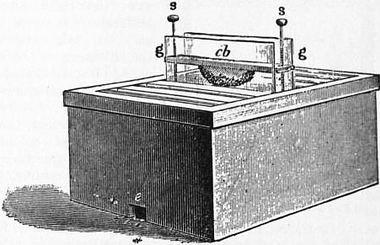and how the lower portion allows the bees to cluster around the tender larvae and thus maintain the warmth necessary during its metamorphosis from the egg to the perfect insect. The horizontal section (B) with equal clearness demonstrates the bee’s ingenuity in economizing space, showing how the outer combs are used exclusively for stores, and, as such, may be built of varying thickness as more or less storage room is required. The straw skep has, however, the irredeemable fault of fixed combs, The movable-frame hive.and the gradual development of the movable-frame hive of today may be said to have first appeared in 1789 with the leaf-hive of Huber, so called from its opening like the leaves of a book. Prior to that date wooden box-hives of various shapes had been adopted by advanced bee-masters anxious to increase their output of honey, and by enthusiastic naturalists desirous of studying and investigating the wonders of bee-life apart from the utilitarian standpoint. Foremost among the latter was the distinguished Swiss naturalist and bee-keeper, François Huber, who was led to construct the leaf-hive bearing his name after experimenting with a single comb observatory hive recommended by Réaumur. Huber found that although he could induce swarms to occupy the glass-sided single frame advised by Réaumur, if the frame was fitted with ready-built pieces of comb patched together before hiving the swarm, the experiment was successful, while if left to themselves the bees built small combs across the space between the sheets of glass, and the desired inspection from the outside was thus rendered impossible. He also gathered that the abnormal conditions forced upon the bees by a ready-built single comb might so turn aside their natural instincts as to render his investigations less trustworthy than if conducted under perfectly natural conditions; so, in order to remove all doubt, he decided to have a series of wooden frames made, measuring 12 in. sq., each of rather more than the ordinary width allowed for brood-combs. These frames were numbered consecutively 1 to 12, and hinged together as shown in fig. 12 (h, A). In this way the frames of comb could be opened for inspection like a book, while when closed the bees clustered together as in an ordinary hive. Ten of these frames had a small piece of comb fixed to the top-bar in each, supported (temporarily) by a thin lath wedged up with pegs at side, the latter being removed when the comb had been made secure by the bees. When closed, the ten frames, together with the two outside ones (fitted with squares of glass for inspection), which represent the covers of the book, were tied together with a couple of stout strings. In a subsequent form of the same hive Huber was enabled—with the help of very long thumb-screws at each side (fig. 13)—to raise up any frame Huber’s observatory hive.between two sheets of glass which confined the bees and allowed him to study the process of comb-building better than any hive we know of today. By means of the leaf-hive and using the entrances (fig. 12, e, e, A) Huber made artificial swarms by dividing and the use of division-boards, though not in quite the same fashion as is practised at the present day. On the other hand, it must be admitted that Huber’s hive was defective in many respects; the parting of each frame, thus letting loose the whole colony, caused much trouble at times, but it remained the only movable-comb hive till 1838, when Dr Dzierzon—whose theory of parthenogenesis has made his name famous—devised a box-hive with a loose top-bar on which the bees built their combs and a movable side or door, by means of which the frames could be lifted out for inspection. This improvement was at once appreciated, and in the year 1852 Baron Berlepsch added side-bars and a bottom-bar, thus completing the movable frame.

|
| Fig. 13.—Huber’s bar-hive, showing how comb is built, cb, Comb bar; g, g, glass sheets; s, s, screws; e, entrance. (From Cheshire’s Bees and Bee-keeping, Scientific and Practical.) |
About the same time the Rev. L. L. Langstroth was experimenting on the same lines in America, and in 1852 his important invention was made known, giving to the world of bee-keepers a movable frame which in its most important details will never be excelled. We refer to the Laagstroth’s hive.respective distances left between the side-bars and hive walls on each side, and between the lower edge of the bottom-bars and the floor-board. Langstroth, in his measurements, hit upon the happy mean which keeps bees from propolizing or fastening the frames to the hive body, as they assuredly would do if sufficient space had not been allowed for free passage round the side-bars; it is equally certain that if too much space had been provided, they would fill it with comb and thus render the frame immovable. In addition to these benefits, Langstroth’s frame and hive possessed the enormous advantage over Dzierzon’s of being manipulated from above, so that any single frame could be raised for inspection without disturbing the others. Langstroth’s space-measurements have remained practically unaltered notwithstanding the many improvements in hive-making, and in the various sizes of movable frames, since introduced and used in different parts of the world.
In the United States of America Langstroth’s frame and hive are the acknowledged “standards” among the great body of bee-keepers, although about a dozen different frames, varying more or less in size, have their adherents. Among these may be named the American, Adair, Size of frames in
the U.S.A.Danzenbaker, Gallup, Heddon, Langstroth and Quinby. Three of these, the American, Adair and Gallup, may

